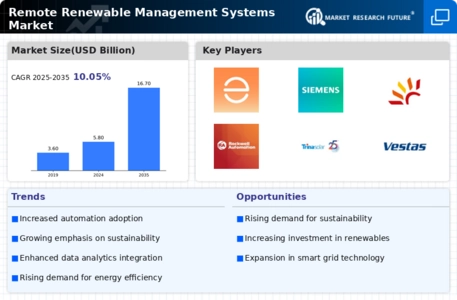Top Industry Leaders in the Remote Renewable Management Systems Market
*Disclaimer: List of key companies in no particular order
Top listed global companies in the Remote Renewable Management Systems industry are:
CGI Inc., SYS TEC electronic AG, Lightings, Hitachi ABB Power Grid, Honeywell, Cummins Inc, Outback Power Inc., Cahors, Capgemini, KEPCO KDN.
Bridging the Gap by Exploring the Competitive Landscape of the Remote Renewable Management Systems Top Players
The Remote Renewable Management Systems (RRMS) market is experiencing fervent growth, fueled by the surging adoption of renewable energy sources, particularly solar and wind. These software and hardware solutions enable efficient monitoring, control, and optimization of remote renewable assets, unlocking substantial operational benefits and cost savings. Navigating this dynamic landscape requires a close inspection of the key players, their strategies, and emerging trends.
Market Share Analysis: Decoding the Power Players
A handful of established players currently dominate the RRMS market, including industry giants like GE, ABB, Siemens, and Schneider Electric. These companies boast comprehensive solutions encompassing hardware, software, and data analytics, catering to diverse renewable asset types and scales. Their extensive experience, global reach, and established customer base grant them a significant edge in securing large-scale projects.
However, the competitive tide is turning. A new wave of agile startups is disrupting the market with innovative offerings focused on niche segments, cloud-based solutions, and advanced data analytics capabilities. Companies like GreenPowerMonitor, 3F, and sonnen offer modular, cost-effective RRMS solutions, particularly appealing to smaller renewable installations and distributed energy grids.
Factors like geographic expertise, vertical specialization, and technological prowess play a crucial role in determining market share. Companies catering to specific regions like sonnen in Europe or GreenPowerMonitor in Spain hold territorial advantages. Meanwhile, players like 3F, specializing in wind farm management, carve out their niche by tailoring solutions to unique asset demands.
Strategic Maneuvers: Adapting to Thrive
Established players are not standing idle. Recognizing the shifting landscape, they are pursuing strategic acquisitions and partnerships to bolster their offerings and tap into new markets. GE's acquisition of Silver Spring Networks and ABB's collaboration with sonnen are prime examples of this trend. Additionally, incumbents are investing heavily in research and development, focusing on advanced analytics, artificial intelligence, and blockchain integration to enhance system intelligence and predictive maintenance capabilities.
Startups, on the other hand, thrive on their agility and responsiveness. They rapidly deploy cutting-edge technologies like machine learning and edge computing, catering to the evolving needs of a data-driven industry. Their focus on user-friendly interfaces and cloud-based deployments makes them particularly attractive to tech-savvy clients.
Emerging Trends: Shaping the Future of RRMS
The RRMS market is constantly evolving, driven by technological advancements and changing market dynamics. Key trends shaping the future include:
Integration with IoT and Smart Grids: RRMS platforms are increasingly integrating with Internet of Things (IoT) sensors and smart grid technologies, enabling real-time data exchange and intelligent energy management. This fosters grid stability and maximizes renewable energy utilization.
Cloud-based Solutions: Cloud-based RRMS solutions are gaining traction due to their scalability, accessibility, and cost-effectiveness. This eliminates the need for on-site infrastructure and facilitates remote monitoring and management, particularly for geographically dispersed assets.
Cybersecurity Concerns: As RRMS become more sophisticated, cybersecurity threats become a rising concern. Companies are focusing on robust security protocols and data encryption to safeguard critical infrastructure and prevent unauthorized access.
Focus on O&M Optimization: RRMS are evolving beyond data monitoring to encompass predictive maintenance and automated fault detection. This minimizes downtime, optimizes O&M costs, and extends the lifespan of renewable assets.
The Competitive Outlook: A Collaborative Future
The RRMS market is witnessing both fierce competition and strategic collaboration. While established players leverage their experience and resources, startups bring innovation and agility to the table. The future is likely to see a blend of these approaches, with traditional companies incorporating cutting-edge technologies and startups scaling their operations to cater to larger projects.
Collaboration between players across the value chain, including renewable energy developers, utilities, and technology providers, will be crucial to unlocking the full potential of RRMS. Open data platforms and standardized communication protocols can foster interoperability and accelerate the development of a robust and efficient renewable energy ecosystem.
In conclusion, the RRMS market is a dynamic and rapidly evolving space. Understanding the competitive landscape, key player strategies, and emerging trends is crucial for both established companies and aspiring startups to navigate this exciting domain and contribute to the sustainable energy future.
Latest Company Updates:
CGI Inc.: November 22, 2023: Announced a partnership with GreenYellow to develop and deploy a smart grid platform for managing renewable energy assets in France. (Source: CGI press release)
SYS TEC electronic AG: October 25, 2023: Launched the "ScadaSuite 7" remote monitoring and control system with enhanced features for managing distributed energy resources, including renewables. (Source: SYS TEC press release)
Lightings: December 12, 2023: Acquired GridBeyond, a provider of AI-powered energy management and optimization solutions for renewables. (Source: Lightings press release)
Hitachi ABB Power Grids: January 10, 2024: Announced the launch of the "MicroSCADA Pro V14" platform with improved capabilities for managing and integrating renewable energy sources into microgrids. (Source: Hitachi ABB Power Grids website)









